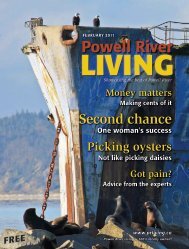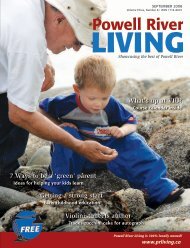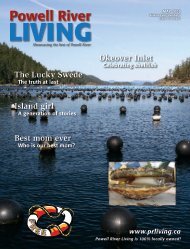difference
To Shop For - Powell River Living
To Shop For - Powell River Living
- No tags were found...
You also want an ePaper? Increase the reach of your titles
YUMPU automatically turns print PDFs into web optimized ePapers that Google loves.
Time to plant<br />
By Jonathan van Wiltenburg<br />
Wiggling currants!<br />
Over the past year I have had people<br />
asking about a particular nasty little<br />
pest that affects their currant shrubs year<br />
after year. The common complaint is a<br />
small rice sized maggot found squirming<br />
around in the berry. It is quite gross,<br />
and usually renders the berries fit for the<br />
birds.<br />
I thought I would get to the bottom of<br />
it and give some solutions to combat this<br />
particular pest.<br />
The pest is a little yellow fly (Euphranta<br />
canadensis) commonly known as the<br />
currant fruit fly. It infects currants (red,<br />
black, or white) and also gooseberries<br />
and is found throughout North America.<br />
The fly itself is about the size of a small<br />
housefly and it lays a single egg under<br />
the skin of a developing berry. The bad<br />
news for us is that each female can lay<br />
over 150 eggs, and each egg is deposited<br />
on its own single berry. However, not<br />
Priorities for April<br />
• April is the time for lawn maintenance.<br />
Take advantage of the moist spring weather<br />
and get all the seeding, aerating, or topdressing<br />
finished before the sun is here.<br />
• If you have not already done so, begin<br />
turning over the garden. Mix in your old<br />
compost from last year. Try not to compact<br />
the newly turned over soil. Amend further<br />
with lime, manure, or mulch if necessary.<br />
• Spilt up and move your perennials.<br />
• Feed your fruit trees, berries, and other<br />
trees and shrubs. Don’t go overboard. Be<br />
sure to use an appropriate fertilizer for the<br />
particular species. Use compost or an organic<br />
fertilizer if you can manage it.<br />
• In you have not done so, prune back your<br />
and hydrangeas, buddleja, fuchsia, Russian<br />
sage, and other plants that flower on present<br />
year wood. Also prune the shrubs that have<br />
already finished flowering; winter jasmine,<br />
forsythia, witch-hazel, kerria, heather, etc.<br />
• Set out your cleaned mason bee houses<br />
all of the injected eggs<br />
will survive. Many of<br />
the berries will drop<br />
prematurely due to<br />
the injection by the female.<br />
As the fly larvae<br />
mature they will drill<br />
a small breathing hole<br />
into the skin of the<br />
fruit. This is the signature<br />
that will tell<br />
you have a problem.<br />
(Look for a small dark<br />
spot on the skin of the<br />
berry). Once fully mature, the larvae<br />
leave the berry and fall to the ground<br />
(sometimes the whole berry falls to the<br />
ground instead), where they bury themselves<br />
into the soil around the base of<br />
the currant bush. Here they overwinter<br />
as pupae until the following spring<br />
ASAP. Keep an eye out for the hard little<br />
workers as they pollinate your fruit trees<br />
and berries.<br />
• Sow your vegetable and flower seed. Vegetables<br />
such as greens and others you want<br />
to eat all season long sow a little bit of seed<br />
more often. Aim for every three weeks.<br />
Sow other crops such as squash, lettuce,<br />
beets, spinach, greens, carrots, parsnips,<br />
chard, celery, early potatoes, leek, onion,<br />
and summer flowering annuals.<br />
• Don’t get too eager! Hold off on planting<br />
anything outside that cannot handle a potential<br />
frost or could be affected by cool<br />
nights. Beans, tomatoes, squash, peppers,<br />
eggplant, are the classic heat lovers. Unless<br />
you have sufficient insulation such as<br />
cold frames or cloches, keep them sheltered<br />
until early May.<br />
• Harvest your early crop of rhubarb and<br />
possibly your asparagus. Continue this for<br />
the next six or so weeks.<br />
Click on mother-nature.ca for<br />
coupons, sales and tips!<br />
when they will emerge as adult flies<br />
ready to complete the cycle once again.<br />
How do you get rid of them?<br />
Because the larvae are encased in the fruit,<br />
they are hard to control. Currently the best<br />
way to knock back the populations are to<br />
disrupt the life cycle of the pest.<br />
One of the suggested methods is to place<br />
a sheet of plastic or cloth on the ground<br />
to catch the larvae before they squirm<br />
into the ground to overwinter. Check on<br />
this sheet daily and dispose of larvae and<br />
berries. Do not put them in the compost!<br />
Rather, put them in a bucket with some<br />
soapy water. Alternatively, others suggest<br />
that if you have chickens to pen a few of<br />
them up around the base of the current<br />
bush and have them peck and scratch.<br />
To prevent new infestation on uninfected<br />
bushes, cover your bushes with<br />
floating row cover from April until late<br />
June when the female flies are busy laying.<br />
This will provide a barrier of entry<br />
and protect the newly forming berries<br />
from infection.<br />
Jonathan van Wiltenburg has a degree in<br />
horticulture and runs Eden Horticulture Services.<br />
You can reach him atedenhort@gmail.com.<br />
Have you<br />
found Waldo yet?<br />
Check the web for<br />
details, then come<br />
down to the store to<br />
find him and win!<br />
Scan this with your smart phone<br />
Get the app at mobiletag.com<br />
Who knows better than Mother Nature?<br />
7050 Duncan Street 604 485-9878<br />
42 • www.PRLiving.ca

















